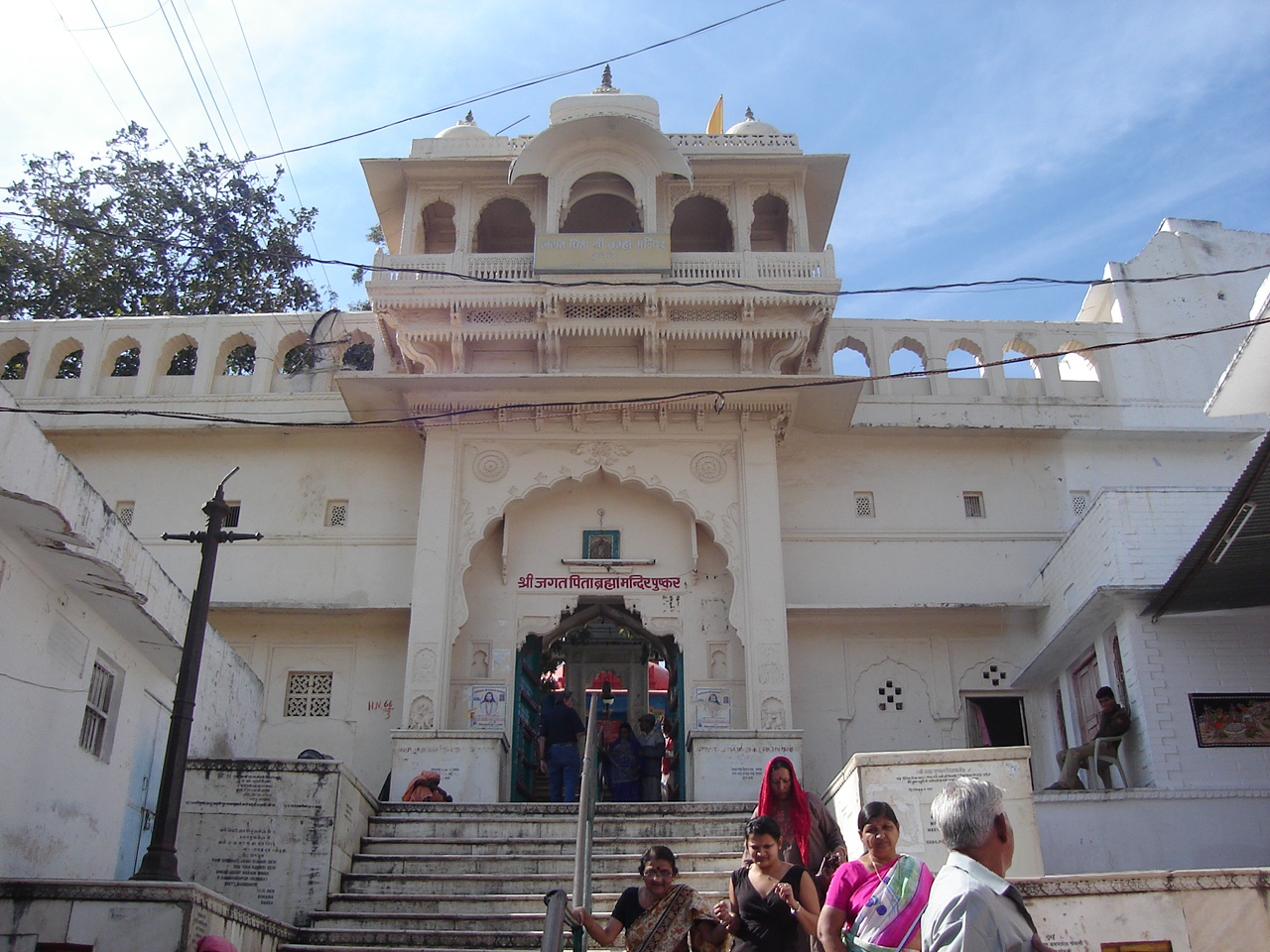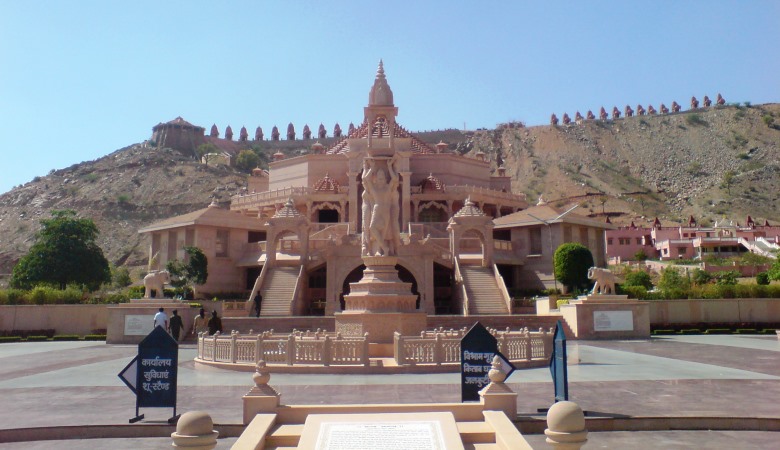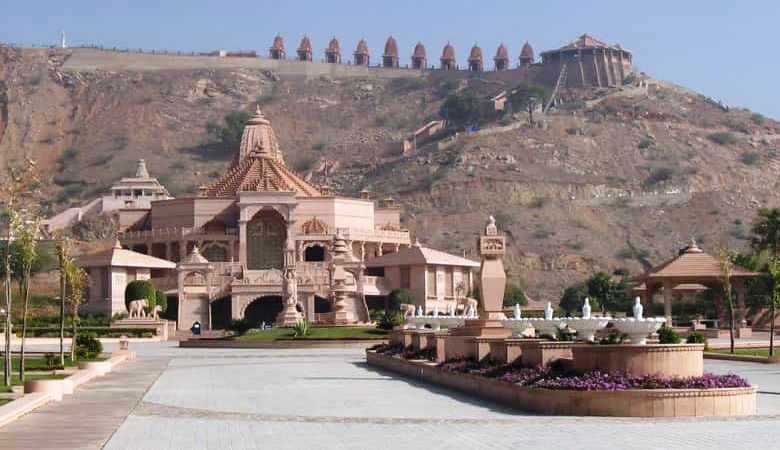
Ajmer Jain Temple Ajmer
About Ajmer Jain Temple
Ajmer Jain Temple, also known as Soniji Ki Nasiyan, is an architecturally rich Jain temple. It was built in the late nineteenth century. The main chamber, known as the Swarna Nagari "City of Gold", has several gold-plated wooden figures, depicting several figures in the Jain religion.
Kurt Titze, in his book, "Jainism: A Pictorial Guide to the Religion of Non-Violence" (1998, p. 143), writes on Soniji Ki Nasiyan:
"Ajmer's main attraction is - for the Jainas - the prominently situated Nasiayan Digambara Temple, or rather the two-storied Svarana Nagara Hall behind the temple, better known as the Museum. Both the temple and the museum were built and are still owned by the Sony family of Ajmer. The temple, dedicated to Rishabha or Adinatha in 1865, was constructed of red sandstone in a matter of a few years, but it took twenty-five years, from 1870 to 1895, to fashion - by artisans at Jaipur - the thousands of individual parts required to assemble a three-dimensional replica of the story of Rishabha in accordance with an old manuscript by Acharya Jinasena.
The thought to have such a three-dimensional model for educational purposes occurred to Seth Moolchand Soni, who was born in 1830, only after the completion of the temple. His death in 1891 prevented him from seeing his ambitious work in its finished state.
In many Jaina temples one sees painted or figurative representations of the 'five auspicious events' (pancha-kalyanak) in the life of every Tirthankara: conception, birth, renunciation, enlightenment, and salvation (moksha or nirvana). The one at Ajmer, now over a hundred years old, is by far the largest and most artistic plastic representation of that much-loved mythological narrative. A specially designed hall of 24.3 m by 12.2 m had to be built to display it effectively. It is open to visitors of all religions every day all the year round for a very small entry fee."
Greatly revered by the Digambar sect of the Jains, the Nasiyan temple is dedicated to Lord Rishabhdev, first of the 24 Tirthankars [religious path makers of the Jains] by Rai Bahadur Seth Moolchand and Nemichand Soni. It is situated on Prithvi Raj Marg in Ajmer, the heart of Rajasthan state in India. The foundation of this magnificent Jain temple was laid on 10 October 1864 and the image of the first Tirthankar Lord Rishabhdev (Adinath), was installed in the Sanctum Sanctorum on 26 May 1865. This work was carried out under the able guidance of the great scholar Pandit Sadasukhdasji of Jaipur.
The name of the temple is Siddhkoot Chaityalaya. It is also known as 'Red Temple' as it is built of red sand stone or 'Nasiyan of Seth Moolchand Soni' signifying the founder’s name. After the Svarna Nagri was added to the temple in 1895 A.D. it popularly began to be called as 'Sone ka Mandir' or 'Soni Mandir' emphasizing the golden structure as well as the family name. The halls of this temple are adorned with fascinating series of large, gilt wooden figures and delicate paintings that display scenes from Jain scriptures.
The central image is of Lord Rishabhdev seated in the "Samavasharana" - in which He imparts true knowledge to the suffering humanity, so that they get liberated from the entanglements of life and death. In the year 2005, the 3 Vedi's were renovated and all the idols of Tirthankaras were re-installed amidst religious rituals and ceremonies. In this portion only Jains are allowed to perform their religious rituals.
On entering this historical temple one gets the view of the beautifully and artistically designed 82 feet high Manastambha. R. B. Seth Tikamchand Soni laid the foundation and R. B. Seth Sir Bhagchand Soni built this Manastambha. He, along with his sons Prabhachand, Nirmalchand & Sushilchand consecrated and installed the images of the Jain Tirthankars in it. A big function was held for ten days in June 1953, where along with the members of the Soni family, thousands of others participated.
In the year 1974, in the auspicious presence of 108 Acharya VidhyasagarJi Maharaj, a big library was established by R.B. Seth Sir Bhagchand Soni. The library houses rare Jain scriptures which are extensively used for research by scholars
The temple is being visited by many tourists annually. Distinguished Visitors include India's first President Dr. Rajendra Prasad, Prime Ministers Jawaharlal Nehru, Indra Gandhi, Morarji Desai & Rajiv Gandhi, Commander-in-Chief General K.M.Kariappa. Pre independence the Viceroy and Vicerene of India Lord & Lady Irwin and Lady Willingdon also visited.
It came to R.B. Seth Moolchand Soni’s mind that 5 Kalyanakas of Lord Rishabhdev could be displayed in models. Accordingly, the work started in Jaipur and it took 25 years to complete these replicas of Ayodhya and Mt. Sumeru. The whole structure, covered with gold leaf, is made according to the descriptions contained in Adi Purana written by His Holiness Shri Jina Sen Acharya.
On completion, the models were displayed in Museum Hall in Jaipur. A big fair was celebrated for ten days in 1895 A.D which was attended by H.H.Maharaja Madhosinghji of Jaipur. The models were thereafter installed in the building behind the Main Temple. This Hall is richly painted in variegated colours, and the walls and ceiling are covered with glass mosaic work.
By Air: Approximately 135 kilometres from Ajmer city, the Sanganer Airport located in Jaipur is the nearest airport from Ajmer. The airport is well-connected to major metropolitan cities like Delhi, Mumbai. Once you reach at the airport, you can hire a cab to reach Ajmer. The journey from airport to the city will take around 2 to 3 hours. You can either pre-book a cab or hire from any of the taxi vendors outside the airport.
By Rail: Some of the most popular trains that run daily on this route are Ajmer Shatabdi and Ajmer Rajdhani. Apart from these, other trains are Chetak Express, Ali Sdah Express, Aravalli Express and Bsb Express. Once you reach at the station- you can hire either a taxi or an auto-rickshaw to reach your hotel or anywhere else in the city.
By Road: The Rajasthan State Road Transport Corporation runs deluxe and semi-deluxe buses (both air-conditioned and Non-air-conditioned) connecting Ajmer to nearby cities like Delhi, Jaipur, Udaipur, Jodhpur and Jaisalmer. There are also several private tour operators who run both regular and Volvo buses on this route.
- Hotel garden.
- Hotel mahatma inn.
- Hotel samrat.
- Adhai din ka jhopra.
- Khawaja sharif.
.
.


